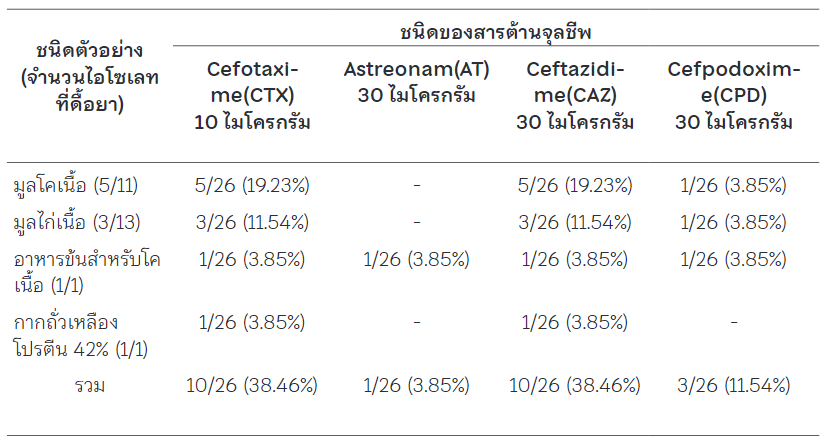Incidence of extended spectrum beta-lactamase producing Escherichia coli isolated from a livestock farm in Sakon Nakhon Province
Keywords:
Antimicrobial resistance, Bacterial metabolites, extended spectrum beta-lactamase, Livestock farmAbstract
Background: Several countries, including Thailand, have reported the prevalence of beta-lactam resistance and/or the discovery of extended spectrum beta-lactamase genes of Escherichia coli in pets, domestic animals’ gastrointestinal tract and urinary tract, and animals consumed by humans. It is also concerning that the E. coli can transmit drug-resistant genes to humans through the food chain, which could result in a serious public health issue if antimicrobial therapies used in humans do not work. Objectives: The aims of this study were to isolate E. coli from a livestock farm in Sakon Nakhon Province, and beta-lactam antimicrobial susceptibilities and ESBL producing of the E. coli isolates were evaluated to provide basic information for the surveillance of antimicrobial resistance spread to humans through food chains. Methods: Escherichia coli isolates from 50 livestock farm samples located in Sakon Nakhon were isolated and phenotypically studied for their antimicrobial sensitivity profiles, extended spectrum beta-lactamase enzymes (ESBL) using a disc diffusion assay, and a combination disc method for confirmation. Results: Twenty-six E. coli isolates of fifty samples were isolated. Ten isolates were resistant to the antimicrobial agents tested, including cefotaxime, aztreonam, ceftazidime, and ceftazidime at 38.46%, 3.85%, 38.46%, and 11.54%, respectively. A combination disc test consisting of cefotaxime and cefotaxime-clavulanic acid, as well as ceftazidime and ceftazidime-clavulanic acid, was used to test all ten E. coli isolates for ESBL enzyme production. Finally, all ten isolates were capable of producing the ESBL enzyme. Conclusions: The findings of this study indicate that animal farms are reservoirs and potential reservoirs of E. coli capable of producing extended spectrum beta-lactamase enzyme, which means this information can be used to monitor the situation of antimicrobial resistance that may affect humans in the future through the food chain.
Downloads
References
Terajima J, Izumiya H, Hara-Kudo Y, Ohnishi M. Shiga Toxin (Verotoxin)-producing Escherichia coli and Foodborne Disease: A Review. Food Saf (Tokyo). 2017;5(2):35-53. Published 2017 Jun 3. https://doi.org/10.14252/foodsafetyfscj.2016029
PMid:32231928 PMCid:PMC6989183
Blaak H, van Hoek AH, Veenman C, et al. Extended spectrum ß-lactamase- and constitutively AmpC-producing Enterobacteriaceae on fresh produce and in the agricultural environment. Int J Food Microbiol. 2014;168-169:8-16. https://doi.org/10.1016/j.ijfoodmicro.2013.10.006 PMid:24211774
Aijuka M, Buys EM. Persistence of foodborne diarrheagenic Escherichia coli in the agricultural and food production environment: Implications for food safety and public health. Food Microbiol. 2019;82: 363-370. https://doi.org/10.1016/j.fm.2019.03.018 PMid:31027795
ปิยะรัตน์ จิตรภิรมย์ และกิจจา จิตรภิรมย์. ESBL เอนไซม์บีตา-แลคทาเมสที่มีฤทธิ์ขยายอำานาจ การดื้อยา. ก้าวทันโลกวิทยาศาสตร์. 2553;10(1): 20-28.
Turner PJ. Extended-spectrum betalactamases.Clin Infect Dis. 2005;41 Suppl 4:S273-S275.
https://doi.org/10.1086/430789 PMid:16032564
Hanhaboon P, Kimprasit T, Wajjwalku W, Amavisit P. Extended Spectrum Betalactamase Producing Escherichia coli Isolated from Infected Canines. Thai J Vet Med. 2015; 45(2): 263-267.
. Li S, Liu J, Zhou Y, Miao Z. Characterization of ESBL-producing Escherichia coli recovered from companion dogs in Tai'an, China. J Infect Dev Ctries. 2017;11(3):282- 286. Published 2017 Mar 31.
https://doi.org/10.3855/jidc.8138 PMid:28368864
Dierikx CM, van der Goot JA, Smith HE, Kant A, Mevius DJ. Presence of ESBL/AmpC-producing Escherichia coli in the broiler production pyramid: a descriptive study. PLoS One. 2013;8(11):e79005. Published 2013 Nov 7. https://doi.org/10.1371/journal.pone.0079005 PMid:24244401 PMCid:PMC3820706
Trongjit S, Chuanchuen R. Whole genome sequencing and characteristics of Escherichia coli with co-existence of ESBL and mcr genes from pigs. PLoS One. 2021;16(11): e0260011. Published 2021 Nov 16. https://doi.org/10.1371/journal.pone.0260011 PMid:34784400 PMCid:PMC8594834
Overdevest I, Willemsen I, Rijnsburger M, et al. Extended-spectrum β-lactamase genes of Escherichia coli in chicken meat and humans, The Netherlands. Emerg Infect Dis. 2011;17(7):1216-1222. https://doi.org/10.3201/eid1707.110209 PMid:21762575 PMCid:PMC3381403
Päivärinta M, Latvio S, FredrikssonAhomaa M, Heikinheimo A. Whole genome sequence analysis of antimicrobial resistance genes, multilocus sequence types and plasmid sequences in ESBL/AmpC Escherichia coli isolated from broiler caecum and meat. Int J Food Microbiol. 2020;315: 108361. https://doi.org/10.1016/j.ijfoodmicro.2019.108361 PMid:31734617
Apostolakos I, Feudi C, Eichhorn I, et al. High-resolution characterisation of ESBL/pAmpC-producing Escherichia coli isolated from the broiler production pyramid. Sci Rep. 2020;10(1):11123. Published 2020 Jul 7. https://doi.org/10.1038/s41598-020-68036-9 PMid:32636426 PMCid:PMC7341882
Zheng B, Feng C, Xu H, et al. Detection and characterization of ESBL-producing Escherichia coli expressing mcr-1 from dairy cows in China. J Antimicrob Chemother. 2019;74(2):321-325. https://doi.org/10.1093/jac/dky446 PMid:30418551
Kimprasit T, Kumla S, Sirilaophaisan S, Sukontasing S, Hondo E, Iida A, et al. Prevalence and characteristics of extended spectrum beta-lactamase producing Escherichia coli isolated from flies in rural Sakon Nakhon, Thailand. Agr. Nat. Res. 2022; 56(6): 1077-1082. Available from: https://doi.org/10.34044/j.anres.2022.56.6.02
Clinical and Laboratory Standards Institute (CLSI). Performance Standards for Antimicrobial Susceptibility Testing; Twenty-Fourth Informational Supplement. CLSI Document M100-S24, Wayne, 2014;34(1).
WHO. WHO integrated global surveillance on ESBL-producing E. coli using a "One Health" approach: implementation and opportunities. 2021. Available from: https://www.who.int/publications/i/item/who-integrated-global-surveillance-onesbl-producing-e.-coli-using-a-onehealth-approach.
Ben Said L, Jouini A, Klibi N, et al. Detection of extended-spectrum beta-lactamase (ESBL)-producing Enterobacteriaceae in vegetables, soil and water of the farm environment in Tunisia. Int J Food Microbiol. 2015;203:86-92. https://doi.org/10.1016/j.ijfoodmicro.2015.02.023 PMid:25791254
Dahms C, Hübner NO, Kossow A, Mellmann A, Dittmann K, Kramer A. Occurrence of ESBL-Producing Escherichia coli in Livestock and Farm Workers in Mecklenburg-Western Pomerania, Germany. PLoS One. 2015;10(11): e0143326. Published 2015 Nov 25. https://doi.org/10.1371/journal.pone.0143326 PMid:26606146 PMCid:PMC4659621
Grami R, Dahmen S, Mansour W, et al. blaCTX-M-15-carrying F2:A-:B- plasmid in Escherichia coli from cattle milk in Tunisia. Microb Drug Resist. 2014;20(4):344-349. https://doi.org/10.1089/mdr.2013.0160 PMid:24428239
Onanga R, Mbehang Nguema PP, Ndong Atome GR, et al. Prevalence of ExtendedSpectrum β-Lactamases in E. coli of Rats in the Region North East of Gabon. Vet Med Int. 2020;2020:5163493. Published 2020 Jul 18. https://doi.org/10.1155/2020/5163493 PMid:32733665 PMCid:PMC7383316

Downloads
Published
How to Cite
Issue
Section
License
Copyright (c) 2023 Chulabhorn Royal Academy

This work is licensed under a Creative Commons Attribution-NonCommercial-NoDerivatives 4.0 International License.
Copyright and Disclaimer
Articles published in this journal are the copyright of Chulabhorn Royal Academy.
The opinions expressed in each article are those of the individual authors and do not necessarily reflect the views of Chulabhorn Royal Academy or any other faculty members of the Academy. The authors are fully responsible for all content in their respective articles. In the event of any errors or inaccuracies, the responsibility lies solely with the individual authors.


